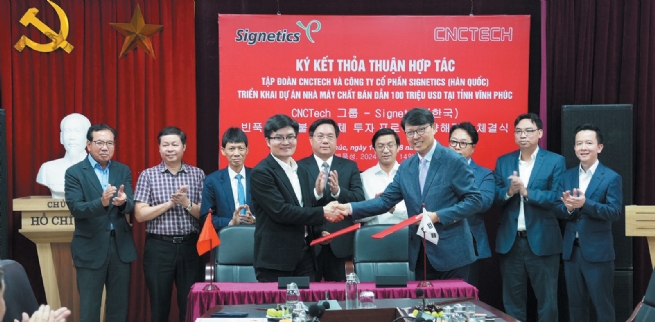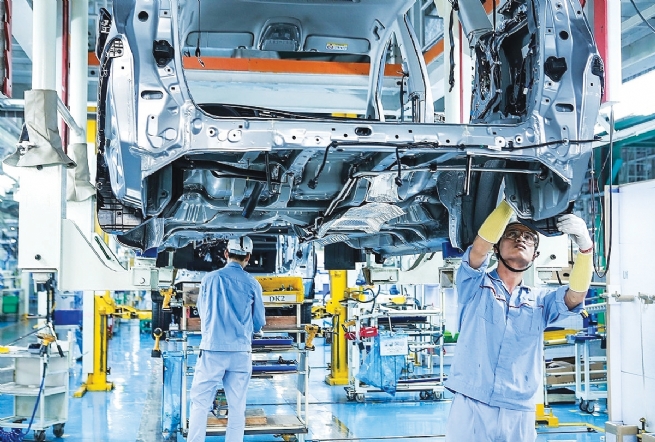1:54:20 PM | 5/26/2025
Vinh Phuc is a leading locality for supporting industries in Vietnam, with hundreds of enterprises manufacturing components and spare parts for major automobile and electronics corporations. However, facing tough challenges, the province must adopt many solutions to achieve breakthroughs in the technology race and enhance its position in the global value chain.

Signetics and CNCTech sign a cooperation agreement on developing a semiconductor factory in Vinh Phuc province
Many enterprises engaged in supporting industries
According to Vinh Phuc province leaders, the supporting industries cover the production and supply of components, spare parts, materials and technical services for key sectors such as automobiles, electronics and mechanical engineering. As Vinh Phuc promotes industrial production to achieve double-digit growth targets, supporting industries play an important role in enhancing domestic production capacity, reducing import dependence, and boosting the competitiveness of major industries by optimizing supply chains and cutting costs.
With advantages such as proximity to Hanoi, modern infrastructure, and large industrial parks like Khai Quang and Binh Xuyen, the province continues to attract FDI, focusing on automobile, motorbike and electronics manufacturing. Supporting industries hold a central position in the local economic strategy, helping increase added value in key sectors, creating thousands of jobs, and driving economic restructuring toward industrialization.
Alongside government policies, Vinh Phuc has introduced its own targeted incentives, including corporate income tax reductions, land rental support in industrial parks and access to low-interest credit.
According to statistics from the Vinh Phuc Department of Industry and Trade, by the end of 2024, the province had around 400 supporting industry enterprises, with more than 70 participating in supply chains for major corporations. Four manufacturers and assemblers of complete automobiles and motorbikes, namely Toyota, Honda, Daewoo Bus and Piaggio, contribute to driving the growth of supporting industry enterprises, particularly in mechanical engineering and vehicle manufacturing.
The industry structure is mainly made up of small and medium-sized enterprises, with active participation from both domestic and foreign firms, notably suppliers for Toyota, Honda, Piaggio, Samsung and LG. According to a report from the Provincial Statistics Office, in 2024, Vinh Phuc’s GRDP reached approximately VND173.14 trillion, rising 9.95% from the previous year. The province also recorded strong growth in attracting foreign direct investment (FDI).
In terms of labor, Vinh Phuc’s supporting industry has created jobs for over 150,200 workers, including 142,440 in industrial parks and more than 7,800 in industrial clusters, accounting for about 25–30% of the province’s total workforce. This figure not only highlights the industry’s large scale but also reflects its role in ensuring social stability. Training support policies, covering up to 70% of costs, have enhanced workers' skills to meet the strict standards of multinational corporations in automobile and electronic component production.
Amid global integration and rapid economic transformation, the three key sectors of Vinh Phuc’s supporting industry have affirmed their position in the international economic value chain. The automobile and motorbike industry, in particular, has grown strongly thanks to major corporations such as Toyota, Honda and Piaggio promoting domestic production. Notably, Toyota has 79 tier-one suppliers (39 domestic and 40 foreign), contributing to technology transfer and the modernization of production processes.
The electronics industry in Vinh Phuc has attracted substantial FDI, with enterprises like Patron Vina and Haesung Vina taking on important leadership roles. In 2024, Vietnam’s electronics export turnover reached about US$126.5 billion. Vinh Phuc contributed over US$2.2 billion from electronic components in the first quarter of 2025.
Meanwhile, the mechanical engineering industry maintains stable growth, driven by the production of industrial machinery and equipment that not only meets domestic demand but also expands into export markets. The combination of preferential policies, technological investment and workforce training continues to be the key driving force behind the steady development of Vinh Phuc’s supporting industry, which is on track to become the province’s economic pillar by 2025.

Toyota Vietnam significantly contributes to Vinh Phuc’s supporting industry
Challenges in developing supporting industries
A leader of Vinh Phuc Department of Industry and Trade shared that the supporting industry in Vinh Phuc still faced many challenges. The dependence on foreign technology makes it difficult for local enterprises to be proactive in production and innovation.
For example, many important components in the automobile and electronics industries still have to be imported from Japan and Korea, increasing costs and reducing domestic added value. The shortage of highly skilled workers is hindering the ability of enterprises to expand production, especially in the context of multinational corporations requiring high-quality human resources to meet international standards.
Although the province’s infrastructure has improved with modern industrial parks, the rapid industrial growth demands further investment in transportation, electricity and water to meet rising needs. At several meetings between the People's Committee leaders and the provincial business association, representatives of the Korean business association in Vinh Phuc expressed concerns about electricity shortages for production. The shortage of skilled human resources, especially high-quality talent, also remains a challenge for businesses.
Facing the impact of the U.S. tariff increase policy, businesses in Vinh Phuc have adopted flexible short-term measures to maintain production and stabilize the market. Key steps include restructuring orders and adjusting export proportions to reduce reliance on the U.S. market while actively exploring other potential markets like Europe, Japan, Korea and the Middle East.
At the same time, businesses are renegotiating trade contracts and seeking cost-sharing from partners to minimize financial risks during this unstable period. They are also focusing on cutting production costs, improving management efficiency, and promoting digital technology in the supply chain to build a foundation for overcoming challenges.
From the business perspective, the representative of CEC Tech Group said, “Systematic investment from leading companies is essential. At CEC Tech, we focus on developing the supporting industry ecosystem through three strategic pillars: industrial parks, supporting industry production, and human resource training, to actively and strongly engage in the semiconductor industry.”
In addition, the provincial authority needs to strengthen the connection between domestic enterprises and FDI enterprises, business networking events and supplier development programs need to be promoted to increase the localization rate, build a sustainable supply chain. It also needs to train high-quality human resources to meet the needs of the supporting industry. Combined with cooperation from leading businesses, these efforts will ensure that labor meets development requirements. Vinh Phuc also needs to expand export markets and actively participate in the global supply chain. Supporting local businesses through market research, trade promotion and international standard certification, as well as encouraging participation in international trade fairs and exhibitions, will help build relationships with potential buyers.
Le Hien, Vietnam Business Forum